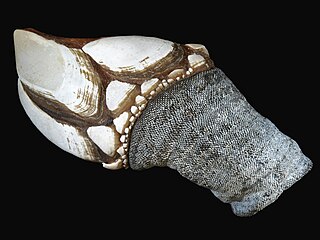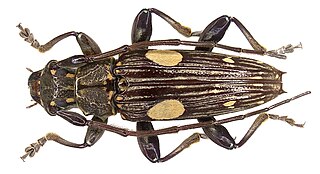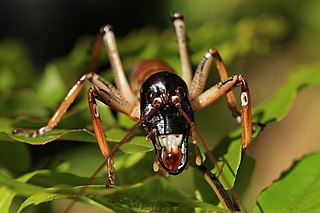
Goose barnacles, also called stalked barnacles or gooseneck barnacles, are filter-feeding crustaceans that live attached to hard surfaces of rocks and flotsam in the ocean intertidal zone. Goose barnacles formerly made up the taxonomic order Pedunculata, but research has resulted in the classification of stalked barnacles within multiple orders of the infraclass Thoracica.

Thoracica is an infraclass of crustaceans which contains the most familiar species of barnacles found on rocky coasts, such as Semibalanus balanoides and Chthamalus stellatus. They have six well-developed limbs, and may be either stalked or sessile. The carapace is heavily calcified. The group includes free-living and commensal species.

Scytodes thoracica is a spitting spider, so called because it spits a venomous sticky silken substance over its prey. Its size ranges between 3–6 mm (0.12–0.24 in). The carapace is unusual in sloping upwards towards its rear end, whereas the abdomen slopes downwards.

The spotted bush warbler is a species of Old World warbler in the family Locustellidae. It is found in the northern Himalayas, Yunnan and central China, in the countries of Bangladesh, Bhutan, China, India, Myanmar and Nepal. Its natural habitat is arboreal forests.

The maroon-belted chat-tyrant, also known as the maroon-chested chat-tyrant or the chestnut-belted chat-tyrant, is a species of bird in the tyrant flycatcher family. It is found in northern South America. Its natural habitats are subtropical or tropical moist montane forests and heavily degraded former forest.

Laphria is a genus described by Johann Wilhelm Meigen in 1803, belonging to the family Asilidae, subfamily Laphriinae. Members of this genus are known as bee-like robber flies. This genus has a Holarctic distribution, occurring in Europe, Asia, and North America. They prey on a variety of insects, including other robber flies, bees, wasps and beetles. Like other asilids, they use their proboscis to penetrate the body of their prey and inject enzymes which dissolve the tissues.

Pascoea is a genus of longhorn beetles of the subfamily Lamiinae, containing the following species:
Pascoea brunneoalba is a species of beetle in the family Cerambycidae. It was described by Gressitt in 1984.
Pascoea mimica is a species of beetle in the family Cerambycidae. It was described by Gressitt in 1984.
Pascoea undulata is a species of beetle in the family Cerambycidae. It was described by Gressitt in 1984.
Pascoea angustana is a species of beetle in the family Cerambycidae. It was described by Kriesche in 1923.
Pascoea bilunata is a species of beetle in the family Cerambycidae. It was described by Kriesche in 1923.
Pascoea bimaculata is a species of beetle in the family Cerambycidae. It was described by Gestro in 1876.

Pascoea degenerata is a species of beetle in the family Cerambycidae. It was described by Heller in 1914.
Pascoea exarata is a species of beetle in the family Cerambycidae. It was described by Francis Polkinghorne Pascoe in 1862. It is known from Moluccas.

Pascoea idae is a species of beetle in the family Cerambycidae. It was described by White in 1855. It is known from Moluccas.
Pascoea meekei is a species of beetle in the family Cerambycidae. It was described by Stephan von Breuning in 1966.
Pascoea parcemaculata is a species of beetle in the family Cerambycidae. It was described by Stephan von Breuning in 1948.

Hemideina thoracica, commonly known as the Auckland tree wētā or tokoriro is a cricket-like insect. It is endemic to New Zealand and is found over most of the North Island, except for the Wellington region and regions 900 metres above sea level. This species is an arboreal, herbivorous generalist however, it is also thought to be polyphagous and is found in all wooded habitats, including forest, scrub and suburban gardens.
Sepsis thoracica, more commonly known as the black scavenger fly, a species of fly from the genus Sepsis and the family Sepsidae. It was discovered by Robineau-Desvoidy in 1830. It resembles a small flying ant. The fly is most commonly found inhabiting cow dung.








